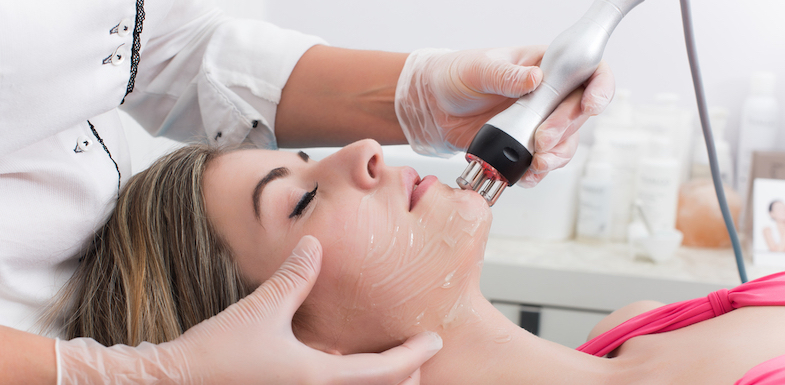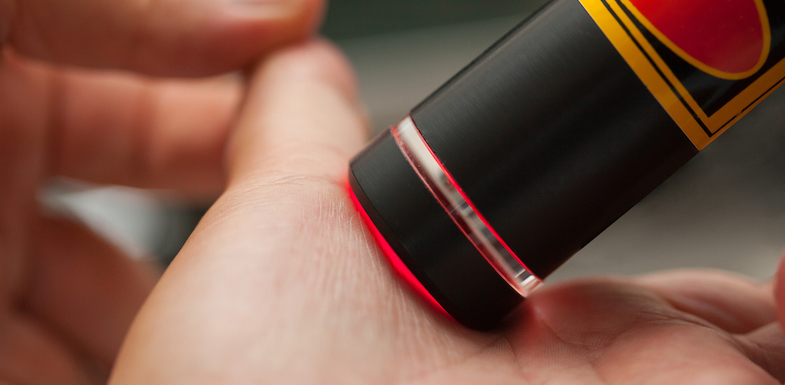Red light therapy is a non-invasive therapy that claims to help treat everything from chronic pain to acne on a cellular level. Also known as low-level laser therapy (LLLT), low-power laser therapy (LPLT), and photobiomodulation (PBM), red light therapy may be a good solution for complex health issues. But what is red light therapy really, and how does it work?
What is red light therapy?
Red light therapy is simple in both theory and practice. Our bodies require light to function well. This light is delivered naturally by the sun, of course. In some cases, a more concentrated version of certain types of light can be highly beneficial.
In red light therapy, safe, low concentrated wavelengths of red and near-infrared light is focused on the body. This can be done as a whole-body treatment or only in targeted areas. The natural red light painlessly penetrates the skin and moves into the body.
In theory, it works due to your body’s use of adenosine triphosphate (ATP).
Once the red light passes through the skin, the mitochondria (part of every cell) absorbs it and begins to produce more ATP. This ATP provides energy for every cell in your body. The extra production of ATP may increase each cell’s ability to do its job. Cells store the ATP for when they need a quick burst of energy—much like a bank holds your money until you need to use it. When ATP production slows, cells have a harder time functioning because they don’t have enough energy to function. Red light therapy can help theoretically fill up a cell’s bank so that energy is available when needed.
This burst of ATP has many potential positive responses in the cells. Cells are able to repair and rebuild more easily, with free movement of oxygen and other fluids. In addition, signaling pathways from cells are opened, which may stimulate healing and trigger an anti-inflammatory response.
History
While you cannot get red light therapy benefits from simply swapping out the lightbulb at your desk, the treatment is now available in a variety of venues, from gyms and spas to your own home.
This therapy has only been around for the past 50 years (since lasers were invented), but the therapeutic use of light in not new. The use of light to “balance the four humors” has been around since antiquity. In 1903, the Nobel Peace Prize in medicine was awarded to Niels Ryberg Finsen for his work with artificial light in therapeutic settings.
So, the color may have changed, but the practice of using light goes back to the 8th century BCE. Today, red light therapy is gaining attention as a potential treatment option for a wide variety of conditions and symptoms.
What are red light therapy benefits?
This therapy seems to target many conditions that are caused by either local or systemic inflammation. Today we recognize light therapy as treatment for the following conditions:
- Rickets
- Psoriasis
- Lupus
- Vitiligo
- Fungal infections
- Eczema
- Sleep disorders
- Emotional well-being and mental health
Consider the following study results.
- For wound healing, red light therapy results include reducing inflammation and stimulating the formation of new blood cells
- Patients with acne see their pores unblocked, inflammation reduced, and skin rejuvenated
- Red light therapy reduces muscle fatigue and soreness and improves recovery time
It also works to improve the health of the skin by:
- Increasing collagen production
- Protecting the cells from further damage
- Improving overall circulation
Red light therapy research is even beginning to build up a body of research for a number of chronic pain conditions.
Red light therapy for fibromyalgia
When using red light therapy for fibromyalgia, the research is mixed. All researchers agree that fibromyalgia pain is complex and challenging to treat. One review of studies in 2018 found that when using red light therapy over a long period of time, patients saw a reduction of pain and restored function. This occurred especially when therapy was focused on trigger points.
Small-scale studies have had positive results, including:
- Relieving pain and improving quality of life
- Improvement of all fibromyalgia symptoms
Other studies are ongoing, but with the low risk of side effects, it seems that red light therapy for fibromyalgia is promising. Adding red light therapy for fibromyalgia is not associated with a risk of side effects. It can be a safe addition to other forms of treatment.
Red light therapy for chronic pain
The U.S. Food & Drug Administration has approved red light therapy for treating minor pains (including arthritis). There is also some evidence that it helps with multiple chronic pain conditions.
Osteoarthritis is a common, wear-and-tear form of arthritis that affects older adults. This condition usually progresses over time and can impact a person’s quality of life. A study in 2014 found red light therapy offered a significant reduction of pain and improvement in function short-term.
For rheumatoid arthritis (another progressive and painful inflammation of the joints), red light therapy reduced pain and improved function in 70% of participants. This result was found in a meta-analysis of 13 research trials. The meta-analysis did note, however, that there was no significant discussion of how the placement, duration, wavelength, and frequency of treatment affected these results.
When it comes to common chronic pain conditions, lower back pain patients may also benefit from this approach. Another randomized, controlled trial of red light therapy addressed this as a treatment option. Over a period of seven weeks, researchers found that the treatment reduced back pain without any adverse effects.
It is clear that some people have received tremendous benefit from this treatment. It is equally clear that more research is needed in this newer avenue of pain management.
How does red light therapy work?
Red light therapy is a complementary therapy that can be a positive addition to other treatments for a variety of conditions.
Read on to learn more about how it works, what to expect during treatment, and answers to other frequently-asked questions.

What is the basic mechanism behind this therapy?
As mentioned above, the mitochondria of your cells, sometimes called the “energy generators,” soak up the rays of the red light. They use this light to then create more energy in a cycle that can help with healing and rejuvenation of tissues and other cells that create them.
Red light therapy actually increases the number of mitochondria as well. In theory, more mitochondria storing more energy promotes more healing.
What types of red light therapy are there?
There are two particular wavelengths of red light therapy—660 nanometers and 850 nanometers—that seem to produce the best result.
How do you receive red light therapy?
Red light therapy can be delivered in one of three ways:
- Lamp or panel of lights
- Special device
- Laser with a red light
The main consideration is that the wavelength is of sufficient strength to be therapeutic. In other words, tanning salons that put a red light bulb in their tanning beds and market them as “antiaging” may not be the best place to receive therapy. Look instead for specially-engineered devices.
Does red light therapy hurt?
Red light therapy delivers light in such a low amount that it does not hurt. There are no UV rays present, so the risk for burning is also not present.
However, concentrating light too close to the skin for a prolonged period of time can be painful.
Can red light therapy be used on its own?
At this point, the consensus seems to be that this therapy is a great addition to a comprehensive treatment plan for the targeted condition, but not a primary treatment.
For example, if you suffer from fibromyalgia, you might receive red light therapy in addition to making changes to your diet, exercising, and taking medication.
Is red light therapy covered by insurance?
Because this treatment is relatively new, most insurance companies do not offer even partial coverage. When it is used as a treatment for skin conditions, your dermatologist may be able to get partial coverage. They can at least ensure your payment goes towards your deductible.
When received in medical settings, each treatment generally costs between $25 and $85 dollars. At-home options cost anywhere from $50 to $250.
How often should I get red light therapy?
Each therapy session lasts about 20 minutes. Most providers recommend ten, 20-minute sessions once a week for ten weeks. They then recommend follow-up sessions every few months.
Your exact treatment plan may differ, depending on the condition being treated and any other treatments you are receiving.
Is red light therapy safe?
As with all treatments, the key question (beyond, “what is red light therapy?”) is whether or not the treatment is safe. The main concern with red light therapy is dosage. Too much light on the skin can eventually cause damage to the tissues, but too little is not effective.
If you are treating yourself at home with red light therapy (more on that below), there is always the risk of using the light improperly. This can result in damage or burns to skin. In the case of red light therapy delivered by laser, damage to the eyes is of slight concern.
The best way to protect yourself against the minimal risk of side effects is to either receive red light therapy in a medical setting or to get assistance from your doctor when you begin treatment. They can advise you on which type of equipment to buy and how to use it safely.
How to get started with red light therapy
Your first therapy session starts when you find a skilled provider. Start with your doctor or pain specialist to see if they have any recommendations for you.
A quick “red light therapy near me” search can also help. This will help you locate spas, integrated health centers, and dermatologists who offer this service near you. Take care to read any online reviews and ask friends and family for recommendations before booking an appointment.
At your appointment, you may have an intake period you’ll discuss information about your condition and any treatments. If your provider is a pain specialist, they will review your diagnosis and ask questions about any current symptoms.
This therapy is administered in a couple of different ways, depending on the area targeted. You’ll either lie down under the lights or your provider will use a lighted wand over the treatment area. You may need to adjust your clothing to access the treatment area, but you won’t generally need to disrobe.
At-home red light therapy
If you’d like to try red light therapy at home, the first thing you need to do is to acquire a tool to deliver the red light. Again, check in with your doctor for recommendations first.
The internet offers many different reviews of red light therapy products, which can also be helpful. You have lots of choices, from handheld wands to full-body panels that can be hung on the back of a door.
Keep in mind the following guidelines when selecting your at-home device:
- Include protective goggles no matter what device you buy (and make sure to wear them!)
- Look for wavelengths of 650 and 850 nanometers
- Read and follow all manufacturer’s guidelines
It can be helpful to keep a symptom tracking journal when you begin a new treatment plan as well. This is especially true for treatments administered at home.
Learn more
We hope this has helped answer the question, “What is red light therapy?” for you. At Arizona Pain, we see red light therapy as another tool in our integrated, comprehensive approach to helping you get your life back from pain.
Get in touch today to schedule your first appointment!
